Topics
Category
Era
Workers Killed During State Capitol Construction, 1898–1903
Men working in the area of the capitol dome, ca. 1901. Note the lack of hardhats as the workers hoist heavy materials above their heads.
Six workers were killed in accidents during the building of the third Minnesota State Capitol between 1898 and 1903. The deaths resulted from unsafe working conditions that labor laws have greatly improved since that time. After being nearly forgotten, the six builders were honored in 2011, 2012, and 2017 by ceremonies and a plaque at the capitol.
The Minnesota State Capitol came at a cost; six workers died building it. These builders were forgotten for more than 100 years after their deaths.
The first worker to lose his life on the construction project was Felix Arthur, who came north with the marble shipped to St. Paul from a quarry in Georgia. He was working on a stone-polishing machine when he got caught in the flywheel. He died in the hospital several hours later, on May 5, 1898, at the age of twenty-five.
Arthur’s family was prominent, so the Georgia Marble Company paid for his elaborate grave marker in Nelson, Georgia. The families of later capitol accident victims did not receive such support.
All other statehouse deaths were caused by falls. John Biersack, the thirty-six-year-old son of Bavarian immigrants to Wisconsin, died in October 1898, a few days after he fell from a hoist. Like all of the other fatal accident victims, Biersack was unmarried and had no children.
A freak accident killed twenty-year-old Albert Swanson, a mold caster from Sweden. The St. Paul Globe’s headline for the story summarized the incident: “Passing Wagon Drives over Rope used to Hoist Materials and Scaffolding, on Which Men Stood, Falls.” Swanson and Frank Thiery fell forty feet; Swanson collided with scaffolding and died before hitting the ground. Thiery landed on a pile of sand and broke his leg but was able to go home from the hospital that night.
Another Swedish immigrant, twenty-year-old stonemason Alfred Magnuson, was the nephew of capitol master stonemason Nils Nelson. Magnuson fell thirty feet on June 25, 1900. He died in St. Joseph’s Hospital four days later.
Florian Zauner was born in Germany forty years before he worked as a laborer on the capitol, where he fell seventy feet and died immediately on August 3, 1900. Few details about the lives of Zauner and Magnuson survive, and their graves are unmarked.
On June 25, 1903, eighteen-year-old John Corrigan fell thirty-two feet to his death in the unfinished House Chamber. After less than two weeks on the job, Corrigan had lost his balance while carrying a heavily-loaded wheelbarrow across a narrow and unguarded gangway.
These accidents stirred controversy about unsafe conditions at the capitol site. An 1899 St. Paul Globe headline read, "Railing Is Needed There—Safety Device Suggested By The Labor Bureau For Capitol Workers."
By June 27, 1903, the outrage in the Minneapolis Journal headline was clear: "Deaths Due To Neglect." The article noted that contractors had been ordered to widen high runways, but they were still too narrow “to protect a man from momentary dizziness.” The outcry over young Corrigan's death may finally have changed worksite conditions. He was the last worker to die during construction of the capitol, which opened to the public in 1905.
While inspectors visited worksites and issued safety orders, they did not have the power to make employers pay fines or face legal consequences. Attitudes about worksite hazards were also different then. HGA architect Ginny Lackovic, who supervised the 2010 capitol dome repairs, said, "I think the level of safety when this building was built was based on everybody's sense of their own judgment. Your safety was your own responsibility and if you made a mistake you paid dearly for it."
Because worker’s compensation laws weren’t enacted in Minnesota until 1913, receiving compensation for workplace accidents required proving negligence by the employer and proper behavior by the employee—a difficult, expensive, and time-consuming process. Mutual benefit societies and unions provided some illness, accident, and death assistance.
Safety laws and technical innovations have greatly improved workplace safety in the 2000s. Insurance programs help those who are injured or killed.
The six builders were finally recognized publicly during Workers Memorial Day ceremonies in 2011 and 2012. They were honored by a plaque installed in the capitol in 2017, thanks to a group of Owatonna middle school students who, after studying the Labor Education Service’s capitol project website, successfully lobbied for a bill authorizing the memorial.
Bibliography
119.C.4.5.B
Bureau of Labor Statistics Biennial Reports, 1888–1930
Minnesota Labor and Industry Department
State Archives, Minnesota Historical Society, St. Paul
Description: The 1903–04 report has detailed information on Minnesota accidents and strikes.
“Capitol Accident Fatal.” St. Paul Globe, June 30, 1900.
“Capitol Gets Sixth Victim.” St. Paul Globe, June 26, 1903.
PR 21
Carsley, George H. "Daily Memorandum" and "Minnesota State Capitol Report"
Cass Gilbert Collection, 1883–1952
Department of Prints, Photographs, and Architectural Collections, New-York Historical Society, New York
Description: Correspondence between architect Cass Gilbert in New York and assistant George Carsley at the capitol site in St. Paul.
http://dlib.nyu.edu/findingaids/html/nyhs/Gilbert
“The City: Friday’s Findings.” St. Paul Dispatch, October 21, 1898.
“Cole Has a Chance.” St. Paul Globe, May 22, 1899.
Davis, Julie. Unpublished research files on capitol construction. Minnesota State Capitol Historic Site, St. Paul.
"Deaths Due to Neglect." Minneapolis Journal, June 27, 1903.
“Dies from the Fall.” St. Paul Pioneer Press, October 21, 1898.
“His Fall Fatal.” St. Paul Globe, October 22, 1898.
“Killed at New Capitol.” St. Paul Globe, August 4, 1900.
Minnesota Board of State Capitol Commissioners. “Biennial Report of the Board of State Capitol Commissioners, Appointed to Construct a New Capitol for the State of Minnesota,1895–1907.”
Available at the Minnesota Historical Society library as F613.S82 M55a.
"One Dead, One Injured." St. Paul Globe, April 28, 1900.
"Only Lived a Few Hours." St. Paul Daily Globe, May 6, 1898.
"Railing Is Needed There." St. Paul Globe, June 7, 1899.
+Reserve 47 Box 1, July 1900
Records, 1892–1914
Board of State Capitol Commissioners
Photograph Collection, Minnesota Historical Society, St. Paul
Description: Photograph album of state capitol construction images, 1896–1905, including workers, equipment, and machinery. All phases of construction work are shown including worker conditions, tools used, materials used, and machinery, including steam powered hoists and derricks. Also includes a view of the stone mill and workshops located around the construction site. Photographers: Haas & Wright.
http://www2.mnhs.org/library/findaids/gr01252/pdfa/gr01252-00001.pdf
"Some Bad Accidents." St. Paul Globe, May 21, 1899.
U.S. Department of Labor Bureau of Labor Statistics. "Fatal Occupational Injuries Counts and Rates By Selected Industries, 2016–17,” Table 4.
https://www.bls.gov/news.release/cfoi.t04.htm
Who Built Our Capitol? Oral history interview with Ginny Lackovic, HGA architect, conducted by Randy Croce, November 2010.
https://whobuiltourcapitol.advantagelabs.com/articles/ginny-lackovic-architect-interview
“Workers’ Memorial Day 2011. YouTube video, 1:21. Labor Education Service, 2011.
https://youtu.be/1f6E6ncvEZM
Related Resources
Primary
A/+G464
Cass Gilbert papers, 1882–1934 (bulk 1882–1910)
Manuscripts Collection, Minnesota Historical Society, St. Paul
Description: Correspondence, contracts, agreements, specifications, sketches, and other materials relating chiefly to buildings designed by Gilbert, an architect who opened offices in St. Paul, Minnesota (1882) and New York City (1899). About one-third relate to the design and construction of the Minnesota State Capitol (1893–1909).
John Carrington (AKA Corinton, Corregan, Bowdin, or Bowden). Post-Mortem Examination Record, J. Ohage, MD, June 25, 1903. Coroner's Record Book, 1901–1975. State Archives of Ramsey County, Record ID 001735745.
Alfred Magnuson (AKA L. Magnuson) Death Card. Death Record Cards, 1900. Minnesota Health Department, St. Paul, Microfilm Roll 13, A–R.
Albert Swanson and Florian Zauner (AKA Florane Zauner) Death Cards.
Death Record Cards, 1900. Minnesota Health Department, St. Paul, Microfilm Roll 13, S–Z.
Secondary
Gardner, Denis P. Our Minnesota State Capitol: From Groundbreaking Through Restoration. St. Paul: Minnesota Historical Society Press, 2005.
Roethke, Leigh. Minnesota's Capitol: A Centennial Story. Afton, MN: Afton Historical Society Press, 2005.
Thompson, Neil B. Minnesota's State Capitol: The Art and Politics of a Public Building. St. Paul: Minnesota Historical Society Press, 2005.
Web
CommunityWalk. Capitol Construction Workers.
http://www.communitywalk.com/st_paul/minnesota/capitol_construction_workers_189818991900/map/1523681
Croce, Randy. "Dayton Signs Bill to Recognize Capitol Builders."
https://whobuiltourcapitol.org/articles/Dayton-signs-bill-recognize-capitol-builders
——— . "Hundreds Attend Ceremony Honoring Capitol Construction Workers.
https://www.whobuiltourcapitol.org/articles/hundreds-attend-ceremony-honoring-capitol-construction-workers
——— . "State Capitol's Stunning Beauty Came at a Terrible Cost."
https://www.whobuiltourcapitol.org/articles/state-capitol%E2%80%99s-stunning-beauty-came-terrible-cost
Croce, Randy, Dan Ganley, David Riehle, John Sielaff, and Victoria Woodcock. Who Built Our Capitol? DVD. Minneapolis: Labor Education Service, University of Minnesota, 2013.
https://www.whobuiltourcapitol.org/articles/video-documentary#overlay-context=articles/who-built-our-capitol-vide
“Individual Stories.” Who Built Our Capitol?
https://www.whobuiltourcapitol.org/glossary
Marble Valley Historical Society.
http://www.marblevalley.org
Description: Information on the quarry in Pickens County, Georgia, that provided the stone for the upper part of the Minnesota State Capitol.
“Work Place Hazards and Fatalities.” Who Built Our Capital?
https://www.whobuiltourcapitol.org/articles/work-place-hazards
Related Images
Worker hanging on to end of hoist chain, three stories above the ground. Original description on print: “Minnesota State Capitol, Cass Gilbert Architect, No. 64, South West Corner, October 28, 1898.” Photograph album, May 1896–November 1905 (+Reserve 47, Box 1). Minnesota Board of State Capitol Commissioners records, 1892–1914.
Original description on print: “Main Front Entrance, Minnesota State Capitol, May 1, 1900.” A passing wagon accidentally pulled down the scaffolding (upper right), causing Albert Swanson to fall to his death and Frank Thiery to break his leg. Photograph album, May 1896–November 1905 (+Reserve 47, Box 1). Minnesota Board of State Capitol Commissioners records, 1892–1914.
Original description in album: “No. 104, South East Dome Foundation Pier, Minnesota State Capitol, May 1, 1900.” Note the unsafe ladder with its bottom rung propped up across a beam, without any rope or clamps to hold it in place. Photograph album, May 1896–November 1905 (+Reserve 47, Box 1). Minnesota Board of State Capitol Commissioners records, 1892–1914.
Hoist made of logs with climbing slats, like the one from which John Biersack fell and died. Original description on print: “111 Minnesota State Capitol, North East View, July 1, 1900.” Photograph album, May 1896–November 1905 (+Reserve 47, Box 1). Minnesota Board of State Capitol Commissioners records, 1892–1914.
Capitol construction site showing the fence that was put up to keep out non-workers to prevent them from being hurt. Original caption on print: “No 191, Minnesota State Capitol, South West Corner, Cass Gilbert Architect, June 1, 1901.” Photograph album, May 1896–November 1905 (+Reserve 47, Box 2). Minnesota Board of State Capitol Commissioners records, 1892–1914.
Setting a column in the capitol rotunda. Magnus Johnson’s uncle, master stonemason Nils Nelson, is shown posing with a trowel. Original caption on print: “Minnesota Capitol, No. 253, April 4, 1904, Cass Gilbert, Architect.” Photograph album, May 1896–November 1905 (+Reserve 47, Box 2). Minnesota Board of State Capitol Commissioners records, 1892–1914.
Original caption on print: “Minnesota State Capitol, No. 255, April 16, 1904.”
Ladder appears to be secured at top and bottom and there is a railing on one side of the scaffolding, but the ends are still open. Photograph album, May 1896–November 1905 (+Reserve 47, Box 2). Minnesota Board of State Capitol Commissioners records, 1892–1914.
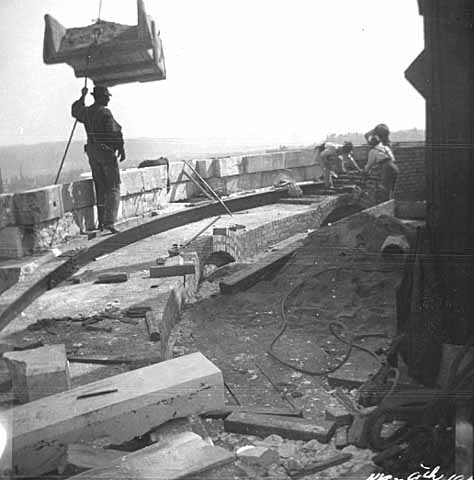
Men working near the capitol dome
Men working in the area of the capitol dome, ca. 1901. Note the lack of hardhats as the workers hoist heavy materials above their heads.
Holding Location
More Information
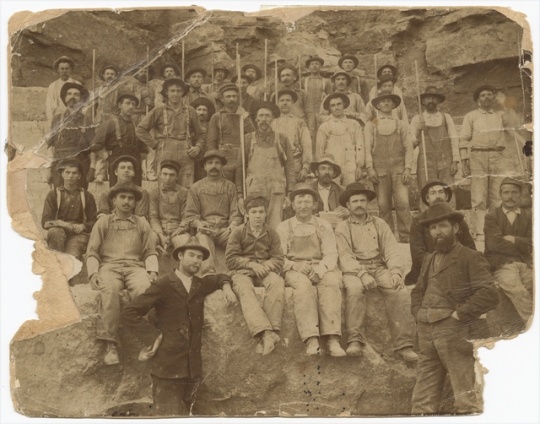
Crew at Biesanz quarry in Winona
Crew at Biesanz quarry in Winona, ca. 1900. These workers drilled the stone used in the foundation of the Minnesota State Capitol.
Holding Location
More Information
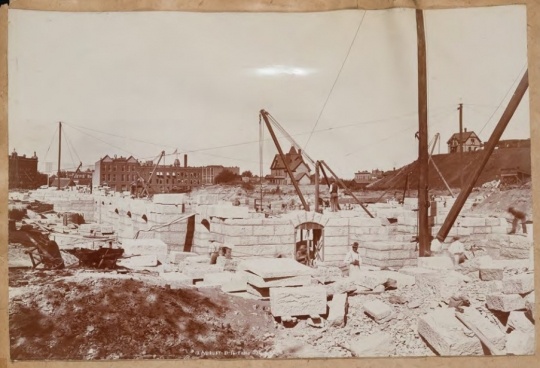
Setting stone blocks for the capitol
Stone workers shaping and setting stone blocks for the capitol. Original description on print: “#13, August 31, 1896–From S.E. Corner.” Photograph album, May 1896–November 1905 (+Reserve 47, Box 1). Minnesota Board of State Capitol Commissioners records, 1892–1914.
Holding Location
More Information
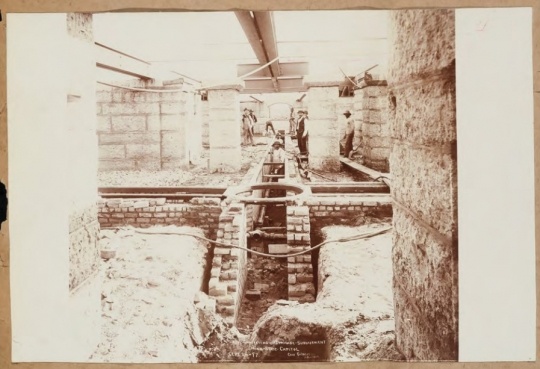
Creating the subbasement of the capitol
Original description on print: “Concreting and drainage–Subbasement, Minnesota State Capitol, #30, September 24, 1897, Cass Gilbert, Architect.” Photograph album, May 1896–November 1905 (+Reserve 47, Box 1). Minnesota Board of State Capitol Commissioners records, 1892–1914.
Holding Location
More Information

View of the capitol, mid-construction
Worker hanging on to end of hoist chain, three stories above the ground. Original description on print: “Minnesota State Capitol, Cass Gilbert Architect, No. 64, South West Corner, October 28, 1898.” Photograph album, May 1896–November 1905 (+Reserve 47, Box 1). Minnesota Board of State Capitol Commissioners records, 1892–1914.
Holding Location
More Information
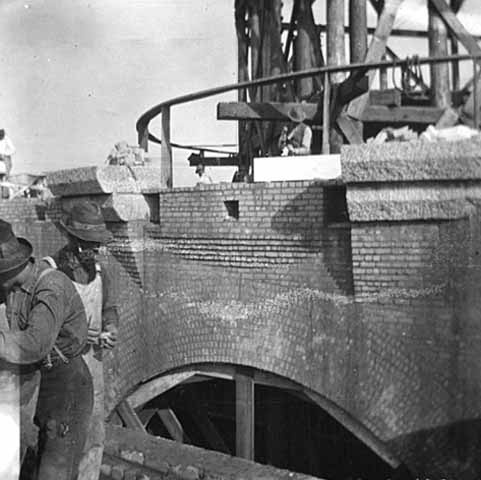
Men working on the base of the capitol dome
Men working on the base of the capitol dome, ca. 1900.
Holding Location
More Information
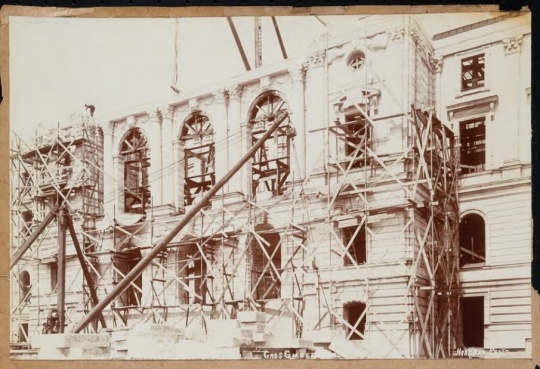
Scaffolding at the front entrance to the capitol
Original description on print: “Main Front Entrance, Minnesota State Capitol, May 1, 1900.” A passing wagon accidentally pulled down the scaffolding (upper right), causing Albert Swanson to fall to his death and Frank Thiery to break his leg. Photograph album, May 1896–November 1905 (+Reserve 47, Box 1). Minnesota Board of State Capitol Commissioners records, 1892–1914.
Holding Location
More Information

Capitol dome interior during construction
Original description in album: “No. 104, South East Dome Foundation Pier, Minnesota State Capitol, May 1, 1900.” Note the unsafe ladder with its bottom rung propped up across a beam, without any rope or clamps to hold it in place. Photograph album, May 1896–November 1905 (+Reserve 47, Box 1). Minnesota Board of State Capitol Commissioners records, 1892–1914.
Holding Location
More Information
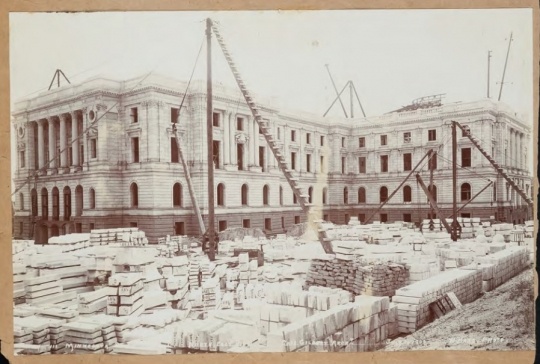
Hoist with climbing slats
Hoist made of logs with climbing slats, like the one from which John Biersack fell and died. Original description on print: “111 Minnesota State Capitol, North East View, July 1, 1900.” Photograph album, May 1896–November 1905 (+Reserve 47, Box 1). Minnesota Board of State Capitol Commissioners records, 1892–1914.
Holding Location
More Information
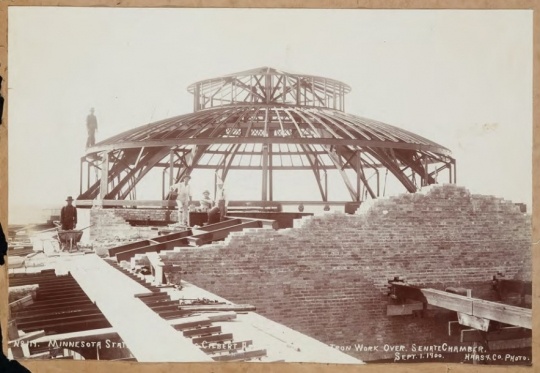
Constructing the roof of the capitol's senate chamber
Original description on print: “No. 119 Minnesota State Capitol, Cass Gilbert Architect, Iron Work Over Senate Chamber, September 1, 1900.” Photograph album, May 1896–November 1905 (+Reserve 47, Box 1). Minnesota Board of State Capitol Commissioners records, 1892–1914.
Holding Location
More Information
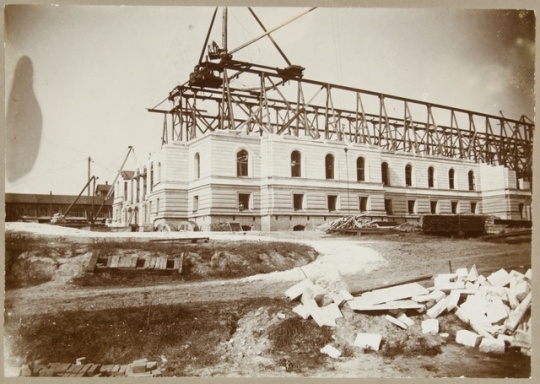
State capitol construction
State capitol construction, ca. 1901.
Holding Location
More Information

Men working on the capitol
Men working on the capitol, ca. 1901. Note the lack of railings, harnesses, and hardhats.
Holding Location
More Information
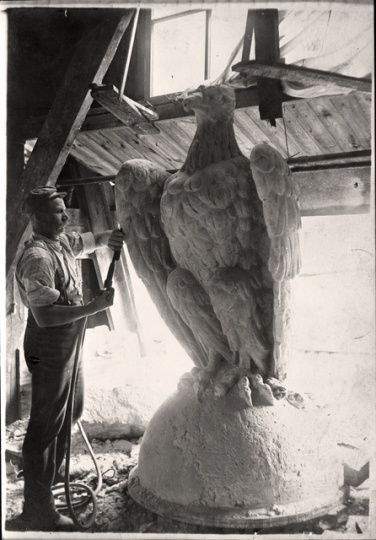
Man working on the eagle at the top of the capitol
Man working on an eagle sculpture for the top of the capitol, ca. 1901.The lack of equipment to get rid of the dust created a health risk for the stone carvers.
Holding Location
More Information
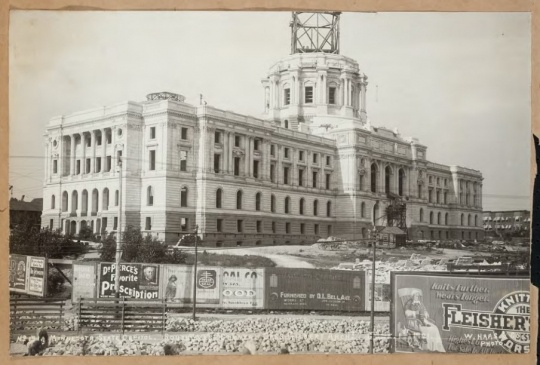
Southwest corner of the capitol construction site
Capitol construction site showing the fence that was put up to keep out non-workers to prevent them from being hurt. Original caption on print: “No 191, Minnesota State Capitol, South West Corner, Cass Gilbert Architect, June 1, 1901.” Photograph album, May 1896–November 1905 (+Reserve 47, Box 2). Minnesota Board of State Capitol Commissioners records, 1892–1914.
Holding Location
More Information
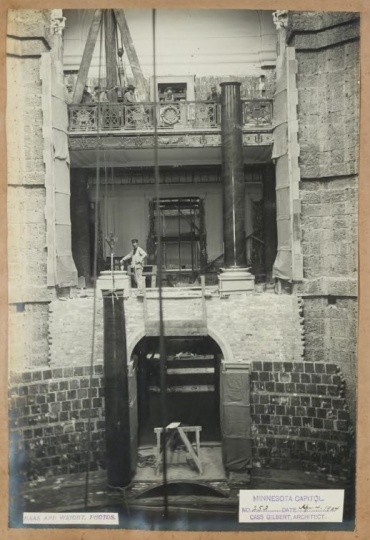
Setting a column in the capitol rotunda
Setting a column in the capitol rotunda. Magnus Johnson’s uncle, master stonemason Nils Nelson, is shown posing with a trowel. Original caption on print: “Minnesota Capitol, No. 253, April 4, 1904, Cass Gilbert, Architect.” Photograph album, May 1896–November 1905 (+Reserve 47, Box 2). Minnesota Board of State Capitol Commissioners records, 1892–1914.
Holding Location
More Information
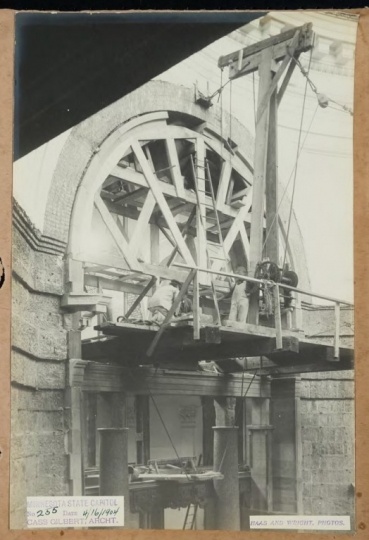
Workers on a temporary platform
Original caption on print: “Minnesota State Capitol, No. 255, April 16, 1904.”
Ladder appears to be secured at top and bottom and there is a railing on one side of the scaffolding, but the ends are still open. Photograph album, May 1896–November 1905 (+Reserve 47, Box 2). Minnesota Board of State Capitol Commissioners records, 1892–1914.
Holding Location
More Information
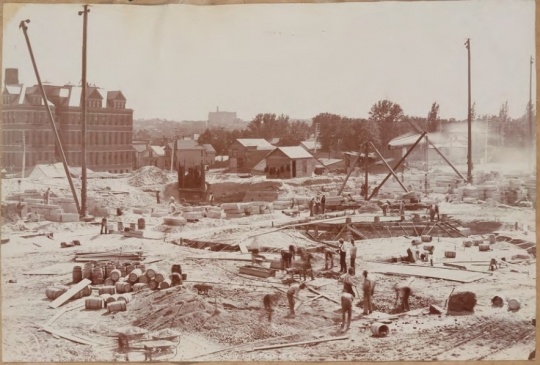
Capitol basement and foundation construction
Early stage of work on Capitol basement and foundation. No description on print except: “#7, July 1, 1896.” Photograph album, May 1896–November 1905 (+Reserve 47, Box 1). Minnesota Board of State Capitol Commissioners records, 1892–1914.
Holding Location
More Information
felixarthurgrave.jpg)
Felix Arthur’s gravestone
Felix Arthur’s gravestone, Nelson, Georgia, ca. 2010. Photograph by Mimi Jo Butler, Marble Valley Historical Society. Used with permission.
All rights reserved
Holding Location
More Information
%20Capitol%20workers%20memorial%20plaque.jpg)
Capitol builders’ memorial plaque
Capitol builders’ memorial plaque, 2017. Photograph by Randy Croce.
© Randy Croce
Holding Location

Toolbox and carpenter's tools used in building the Minnesota State Capitol
Toolbox and carpenter's tools used by William Martin Knudsen during construction of the 1905 Minnesota State Capitol. Contains forty-eight woodworking tools, including drill bits, planes, files, and two hand saws.
All rights reserved
Holding Location
More Information
Related Articles
Turning Point
After the sixth capitol construction worker dies, in 1903, public outcry brings about safer conditions, preventing further deaths.
Chronology
1896
May 4, 1898
October 20, 1898
June 7, 1899
April 27, 1900
June 25, 1900
August 3, 1900
June 26, 1903
June 27, 1903
December 19, 1970
April 28, 2011
April 28, 2012
August 13, 2017
Bibliography
119.C.4.5.B
Bureau of Labor Statistics Biennial Reports, 1888–1930
Minnesota Labor and Industry Department
State Archives, Minnesota Historical Society, St. Paul
Description: The 1903–04 report has detailed information on Minnesota accidents and strikes.
“Capitol Accident Fatal.” St. Paul Globe, June 30, 1900.
“Capitol Gets Sixth Victim.” St. Paul Globe, June 26, 1903.
PR 21
Carsley, George H. "Daily Memorandum" and "Minnesota State Capitol Report"
Cass Gilbert Collection, 1883–1952
Department of Prints, Photographs, and Architectural Collections, New-York Historical Society, New York
Description: Correspondence between architect Cass Gilbert in New York and assistant George Carsley at the capitol site in St. Paul.
http://dlib.nyu.edu/findingaids/html/nyhs/Gilbert
“The City: Friday’s Findings.” St. Paul Dispatch, October 21, 1898.
“Cole Has a Chance.” St. Paul Globe, May 22, 1899.
Davis, Julie. Unpublished research files on capitol construction. Minnesota State Capitol Historic Site, St. Paul.
"Deaths Due to Neglect." Minneapolis Journal, June 27, 1903.
“Dies from the Fall.” St. Paul Pioneer Press, October 21, 1898.
“His Fall Fatal.” St. Paul Globe, October 22, 1898.
“Killed at New Capitol.” St. Paul Globe, August 4, 1900.
Minnesota Board of State Capitol Commissioners. “Biennial Report of the Board of State Capitol Commissioners, Appointed to Construct a New Capitol for the State of Minnesota,1895–1907.”
Available at the Minnesota Historical Society library as F613.S82 M55a.
"One Dead, One Injured." St. Paul Globe, April 28, 1900.
"Only Lived a Few Hours." St. Paul Daily Globe, May 6, 1898.
"Railing Is Needed There." St. Paul Globe, June 7, 1899.
+Reserve 47 Box 1, July 1900
Records, 1892–1914
Board of State Capitol Commissioners
Photograph Collection, Minnesota Historical Society, St. Paul
Description: Photograph album of state capitol construction images, 1896–1905, including workers, equipment, and machinery. All phases of construction work are shown including worker conditions, tools used, materials used, and machinery, including steam powered hoists and derricks. Also includes a view of the stone mill and workshops located around the construction site. Photographers: Haas & Wright.
http://www2.mnhs.org/library/findaids/gr01252/pdfa/gr01252-00001.pdf
"Some Bad Accidents." St. Paul Globe, May 21, 1899.
U.S. Department of Labor Bureau of Labor Statistics. "Fatal Occupational Injuries Counts and Rates By Selected Industries, 2016–17,” Table 4.
https://www.bls.gov/news.release/cfoi.t04.htm
Who Built Our Capitol? Oral history interview with Ginny Lackovic, HGA architect, conducted by Randy Croce, November 2010.
https://whobuiltourcapitol.advantagelabs.com/articles/ginny-lackovic-architect-interview
“Workers’ Memorial Day 2011. YouTube video, 1:21. Labor Education Service, 2011.
https://youtu.be/1f6E6ncvEZM
Related Resources
Primary
A/+G464
Cass Gilbert papers, 1882–1934 (bulk 1882–1910)
Manuscripts Collection, Minnesota Historical Society, St. Paul
Description: Correspondence, contracts, agreements, specifications, sketches, and other materials relating chiefly to buildings designed by Gilbert, an architect who opened offices in St. Paul, Minnesota (1882) and New York City (1899). About one-third relate to the design and construction of the Minnesota State Capitol (1893–1909).
John Carrington (AKA Corinton, Corregan, Bowdin, or Bowden). Post-Mortem Examination Record, J. Ohage, MD, June 25, 1903. Coroner's Record Book, 1901–1975. State Archives of Ramsey County, Record ID 001735745.
Alfred Magnuson (AKA L. Magnuson) Death Card. Death Record Cards, 1900. Minnesota Health Department, St. Paul, Microfilm Roll 13, A–R.
Albert Swanson and Florian Zauner (AKA Florane Zauner) Death Cards.
Death Record Cards, 1900. Minnesota Health Department, St. Paul, Microfilm Roll 13, S–Z.
Secondary
Gardner, Denis P. Our Minnesota State Capitol: From Groundbreaking Through Restoration. St. Paul: Minnesota Historical Society Press, 2005.
Roethke, Leigh. Minnesota's Capitol: A Centennial Story. Afton, MN: Afton Historical Society Press, 2005.
Thompson, Neil B. Minnesota's State Capitol: The Art and Politics of a Public Building. St. Paul: Minnesota Historical Society Press, 2005.
Web
CommunityWalk. Capitol Construction Workers.
http://www.communitywalk.com/st_paul/minnesota/capitol_construction_workers_189818991900/map/1523681
Croce, Randy. "Dayton Signs Bill to Recognize Capitol Builders."
https://whobuiltourcapitol.org/articles/Dayton-signs-bill-recognize-capitol-builders
——— . "Hundreds Attend Ceremony Honoring Capitol Construction Workers.
https://www.whobuiltourcapitol.org/articles/hundreds-attend-ceremony-honoring-capitol-construction-workers
——— . "State Capitol's Stunning Beauty Came at a Terrible Cost."
https://www.whobuiltourcapitol.org/articles/state-capitol%E2%80%99s-stunning-beauty-came-terrible-cost
Croce, Randy, Dan Ganley, David Riehle, John Sielaff, and Victoria Woodcock. Who Built Our Capitol? DVD. Minneapolis: Labor Education Service, University of Minnesota, 2013.
https://www.whobuiltourcapitol.org/articles/video-documentary#overlay-context=articles/who-built-our-capitol-vide
“Individual Stories.” Who Built Our Capitol?
https://www.whobuiltourcapitol.org/glossary
Marble Valley Historical Society.
http://www.marblevalley.org
Description: Information on the quarry in Pickens County, Georgia, that provided the stone for the upper part of the Minnesota State Capitol.
“Work Place Hazards and Fatalities.” Who Built Our Capital?
https://www.whobuiltourcapitol.org/articles/work-place-hazards



















felixarthurgrave.jpg?width=200&height=200&name=3)felixarthurgrave.jpg)
%20Capitol%20workers%20memorial%20plaque.jpg?width=200&height=200&name=5)%20Capitol%20workers%20memorial%20plaque.jpg)
